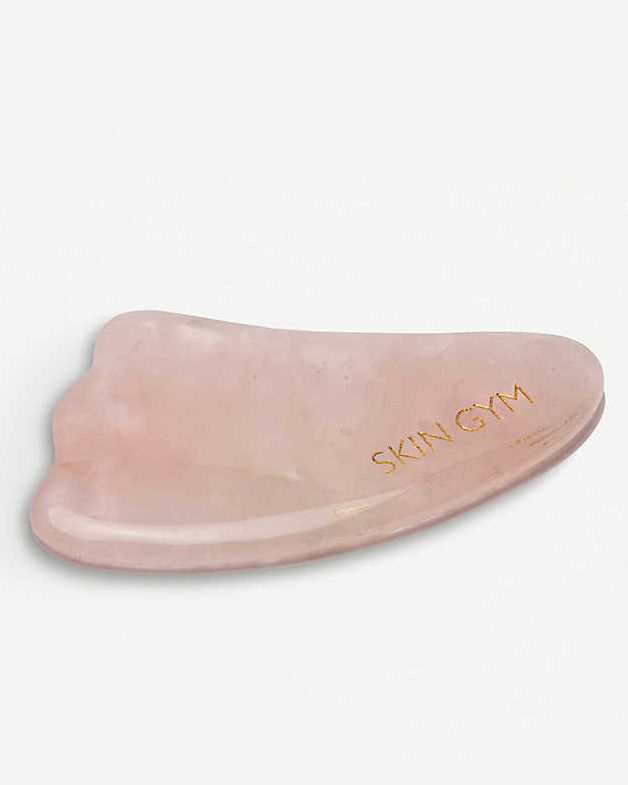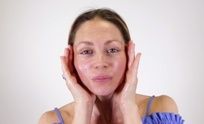“Facial massage is a practical skill that most people can learn and benefit from,” says advanced aesthetician Abigail James, who is known for her holistic yet technical approach to skincare. "This at-home physical method works on muscles, connective tissues, blood and lymph flow in a way your skincare cannot. It’s also a simple and effect therapeutic way of giving some love and attention to yourself, anytime, anywhere.”
She says that we can all gain from incorporating facial massage into our routines, however, some people with skin conditions such as acne and rosacea benefit from a different type of massage, called lymphatic drainage. “A lot of face-lifting massage would irritate these conditions, whereas lymphatic work would benefit them. They are very different methods, and each does take some practice to gain progress.”
James’ new book, The Glow Plan, outlines a four-week guide to happy, healthy skin, incorporating daily face massage suited to your needs. In an extract from the plan, James reveals the best products for successful self-massage, and some no-nos to avoid.
The best products for facial massage
"There are many different products you can use for a great facial massage. My preference is for plant-based oils, balms and cleansers. All of them have a viscous texture that supports the movement of your hands across your skin. There are many beautiful blended oils available on the market.
You need to use enough product to allow you to manipulate your face without tugging or dragging the skin. However, don’t use so much that your fingers slip right off your face. Start with a small amount of product, and you can always add a little more if you feel any friction building up between your fingers and skin.
Some of my favourite oils for face massage (there are many more, of course) are:
Coconut oil: Wonderfully nourishing, it’s ideal for dry skin and brings anti-inflammatory benefits.
Argan oil: Rich in vitamin E, it helps heal and soothe inflammation.
Rosehip seed oil: Light but packed full of vitamins, antioxidants and essential fatty acids, it also helps fade dark spots and supports scar healing.
Sea buckthorn oil: Great for skin healing and regeneration, this is a good source of vitamins B and C, along with omegas 7 and 9.
Shea butter: More like a balm, so allows for a light texture and viscosity on the skin."
What not to use for facial massage
"Mineral oils and paraffin wax: Both coat the skin and are likely to block pores, making them particularly disastrous for oily and acne-prone complexions.
Serums: Being water-based, serums tend to sink into the skin very quickly, rather than providing enough lubrication for massage. Save them for your regular skincare routine to ensure your skin gets a healthy kick of active ingredients, morning and night.
Moisturisers: Again, moisturisers tend to absorb quickly, so are unsuitable for face massage, which can last anywhere between two and twenty minutes. Save them for adding extra hydration to your skin after applying your serum.
Aloe vera gel: While it’s lovely and cooling, it quickly becomes tacky. Your fingers will probably get stuck to it!"
Facial massage tools
"Gua sha: In Chinese, gua means scraping and sha means disease. The treatment used by traditional Chinese medicine practitioners to treat the body has been adapted for cosmetic purposes on the face. You’ll find that there’s now an endless list of facial gua sha tools out there, made of materials such as rose quartz, amethyst, jade and stainless steel.They come in various shapes, often with curved edges that nestle into the facial contours to lift and sculpt them.They’re great for lymphatic drainage and reducing puffiness. I always apply oil first. To get real results, you need to use yours regularly."
"Jade and rose rollers: Like the gua sha, jade rollers are inspired by ancient Chinese tradition. They look a little like small paint rollers – and usually have one larger stone at the top for the forehead, cheeks, jaw and neck, and a smaller one at the bottom for around the eyes and chin. By rolling it back and forth over different areas of the face, using gentle pressure (and after applying oil), it’s said to boost lymph flow and reduce puffiness. The Internet will often present jade rollers as a miracle anti-ageing tool and to be perfectly honest, this is not the case as results are limited. That said, jade rolling (especially if you keep yours in the fridge) can feel extremely soothing and always has a calming effect on my mind. These are valuable benefits in themselves – just don’t expect your face to lose ten years after using one!"
"Cupping: You may well have heard about professional cupping treatments for the body in the media (they’re popular among athletes and celebrities). The tradition is deeply ingrained in Chinese medicine and involves applying glass cups to the body. The cup is heated using a flame to create a suction effect that pulls blood into these areas, flooding the surrounding tissues with fresh, oxygenated blood while promoting new vessel formation. Cupping is also said to relieve muscle tension, support cell repair and encourage cell regeneration. The treatment has more recently been used for rejuvenation purposes. Smaller, softer cups are used on the face, gently suctioning the skin away from the fascia and gliding across the face. I find that it’s a great way to encourage lymph drainage, brighten the skin and encourage a lovely glow."
"Spoons: An oldie but a goodie – one of the things I love about facial massage is that it’s accessible to us all. So, if you don’t want to spend money on tools, you can always pop two teaspoons in the freezer, ready for those mornings when you wake up to find your eyes looking tired and puffy. The cool sensation of the metal will help disperse the build-up of fluid, bring down that puffiness and make you feel more energised for your day ahead."
Facial massage no-nos
"As transformative as facial massage can be, there are some circumstances that require us to take extra care.
If you have active acne: By all means, do a very gentle lymphatic drainage massage. However, anything more vigorous and stimulating should be avoided, as you’ll only aggravate breakouts.
When suffering from rosacea: Stimulating circulation will worsen the appearance of redness and visible blood vessels. Again, light lymphatic drainage is fine.
When you’ve been in the sun: Hot and even slightly pink post-sun skin is only going to find massage irritating. Wait a few days until your skin is cooler and calmer.
While applying prescription retinols: The dryness, flaking and sensitivity that comes with using prescription-strength retinol make it unsuitable for facial massage. Coming up a little pink is normal – and even a great sign that you’ve successfully encouraged healthy blood flow. However, sensitive skin can get very red and angry if massaged.
If you’re taking Roaccutane: This oral medication used to treat severe acne can cause the skin to thin, so take extra care not to tug the skin. Lymphatic drainage is, however, safe.
Using oil for lymphatic drainage: For all its popularity, it’s amazing how many people still use an oil when they perform a lymphatic drainage massage. Using oil means you can easily slip past the delicate lymph nodes, meaning your massage may not be effective at all. It’s better to use clean, dry hands. As you’re only making very light sweeping and pumping movements, you don’t need the glide of an oil as you do with other massage techniques."







